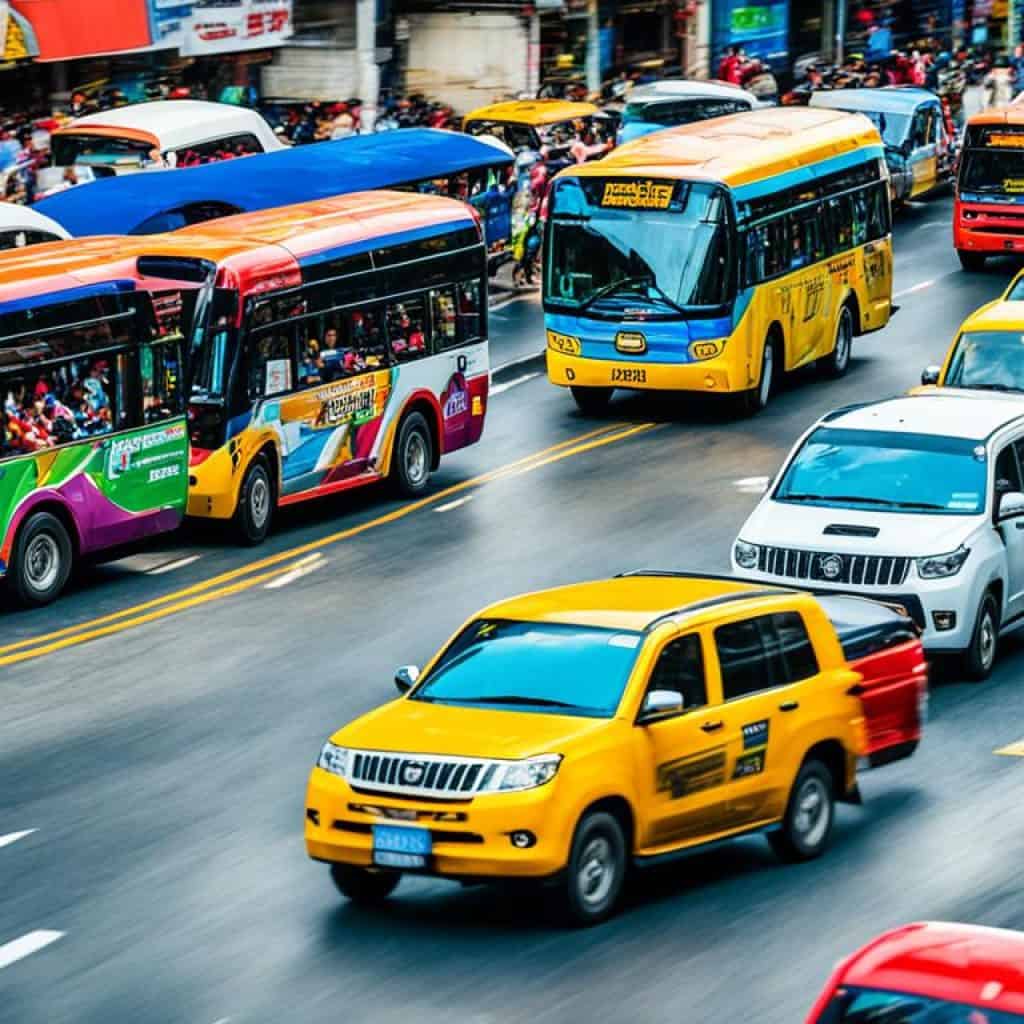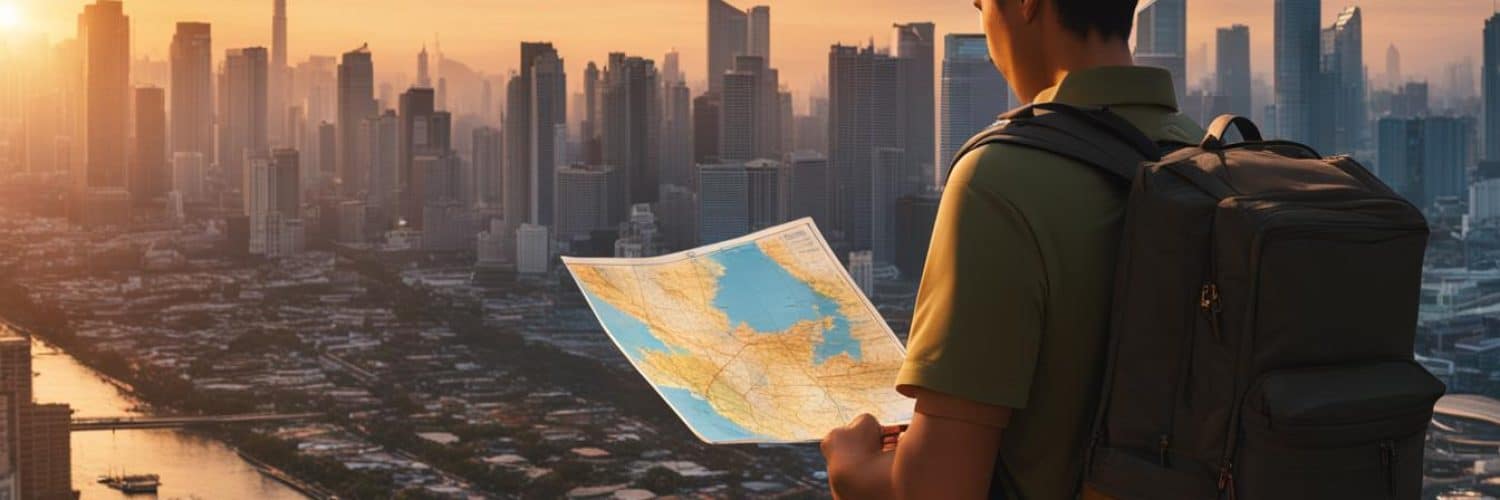Are you a U.S. citizen dreaming of a new life in the beautiful Philippines? Wondering if it’s possible to live there permanently? Well, the answer is…yes! U.S. citizens can legally move to the Philippines and make it their home for the long term.
But how exactly can you make this dream a reality? What are the requirements for permanent residency? And what visa options are available to you? In this article, we’ll explore everything you need to know about living permanently in the Philippines as a U.S. citizen, from visa applications to the benefits of becoming a permanent resident.
Key Takeaways:
- U.S. citizens can live permanently in the Philippines by obtaining the appropriate visa based on their purpose of stay.
- There are various visa options available, including work visas, student visas, retirement visas, spouse visas, and quote visas.
- The Philippines offers a Special Resident Retiree’s Visa (SRRV) for foreign nationals thinking of retiring in the country.
- To become a permanent resident, U.S. citizens must meet specific requirements and go through the visa application process.
- Obtaining permanent residency in the Philippines comes with several benefits, including easier access to loans and insurance, exemption from the need for a return ticket when leaving the country, and no need for visa runs.
Basic Facts About the Philippines
The Philippines, situated in Southeast Asia, offers a vibrant and diverse destination for those seeking a new home. Here are some key facts about this beautiful country:
- Location: The Philippines is located in Southeast Asia, consisting of over 7,000 islands.
- Capital City: The capital city of the Philippines is Manila.
- Languages: The main languages spoken in the country are Filipino and English.
- Population: With a population of approximately 117 million, the Philippines is a melting pot of different cultures and ethnicities.
- Currency: The official currency of the Philippines is the Philippine peso (PHP).
- Government: The Philippines is a democratic and presidential representative federal republic.
- Religion: Christianity is the predominant religion in the Philippines, with Catholicism being the largest denomination.
“The Philippines offers a unique blend of natural beauty, warm hospitality, and a rich cultural heritage. From its stunning beaches to its lively festivals, there is always something to discover and experience in this tropical paradise.” – Travel blogger
As you explore the possibility of living in the Philippines, understanding these basic facts will give you a solid foundation to navigate and appreciate all that this incredible country has to offer. From its breathtaking landscapes to its rich cultural traditions, the Philippines is a land of endless possibilities.
Moving to the Philippines for Work
If you’re a US citizen considering a move to the Philippines for work purposes, it’s essential to understand the requirements and process involved. The Philippines offers various opportunities for expatriates looking to establish their careers in the country.
Work Visa and Alien Employment Permit (AEP)
Documentation and Renewal
When applying for a work visa, you will need to provide documentation proving your identity and employment details. This may include your passport, employment contract, and qualifications relevant to your profession.
The initial work visa is provisional, but it can be renewed to allow for continued employment in the Philippines.
Job Opportunities
The Philippines boasts a thriving job market in various industries, including information technology, business process outsourcing, engineering, and healthcare. Major cities like Manila, Cebu, and Davao are hubs for job opportunities, offering an exciting and diverse work environment.
“The Philippines offers a range of career opportunities for US citizens, from multinational corporations to entrepreneurial ventures. By working in the Philippines, you’ll have a chance to explore a vibrant and growing economy while immersing yourself in the unique culture and beautiful surroundings.”
Benefits of Working in the Philippines
Working in the Philippines can be highly rewarding, both professionally and personally. Some of the benefits include:
- Opportunities for career growth and development
- Competitive salaries and attractive compensation packages
- A dynamic work environment with diverse cultures
- The chance to experience the rich Filipino culture
- Access to beautiful beaches and outdoor activities
Moving to the Philippines to Study
Are you considering moving to the Philippines to pursue higher education? The Philippines offers a range of opportunities for international students, providing a diverse and enriching educational experience. To embark on this exciting journey, US citizens will need to apply for a long-stay student visa and enroll in a recognized Philippine Higher Education Institution (HEI).
Upon your arrival in the Philippines, it is crucial to report to the accepting HEI to initiate the necessary administrative processes. This includes securing important documents from the Bureau of Immigration, such as the Alien Certificate of Registration (ACR) and Certificate of Residence for Temporary Students (CRTS). These documents will validate your student status and ensure a seamless transition into your academic journey.
Studying in the Philippines not only offers access to quality education but also provides an opportunity to immerse yourself in the vibrant Filipino culture. From academic programs tailored to international students, state-of-the-art facilities, to a diverse community of learners, studying in the Philippines can be a transformative experience.
Benefits of Studying in the Philippines
- Cultural Immersion: Immerse yourself in the rich Filipino culture, making lifelong connections and broadening your horizons.
- Diverse Academic Programs: Choose from a wide range of academic programs that cater to various fields of study, ensuring you find the perfect fit for your educational goals.
- Accessible Tuition Fees: Benefit from the affordable tuition fees offered by many Philippine HEIs, making quality education accessible to a wider audience.
- English Proficiency: As English is widely spoken and used as the medium of instruction in Philippine universities, international students can comfortably pursue their studies and engage with faculty and peers.
- Gateway to Southeast Asia: By studying in the Philippines, you gain proximity to other Southeast Asian countries, allowing for easier exploration of the region’s diverse cultures and attractions.
Embark on an exciting educational journey in the Philippines, where you can acquire world-class knowledge, immerse yourself in a vibrant culture, and form life-changing connections. Prepare for an enriching experience that will shape your future and broaden your perspective.

Moving to the Philippines for Retirement
If you’re a US citizen considering retirement in the Philippines, the Special Resident Retiree’s Visa (SRRV) offers a pathway for making your dream a reality. The SRRV program provides various options based on age, deposit, investment, or retirement status, allowing you to choose the plan that best suits your needs.
To be eligible for the SRRV, you must meet specific requirements set by the Philippine government. These requirements typically include maintaining a deposit, making an investment, or having a monthly pension and health insurance policy. By fulfilling these criteria, you can secure your retirement in the Philippines and enjoy the benefits of being a permanent resident.
The SRRV program not only provides retirees with a comfortable and secure environment but also allows them to take advantage of the Philippines’ affordable cost of living, beautiful natural attractions, and vibrant culture. With a wide range of activities and experiences to explore, retirees can enjoy a fulfilling and enriching retirement lifestyle in the Philippines.
“Retirement is a new beginning, and the Philippines offers a perfect destination to start the next chapter of your life. The SRRV program ensures a smooth transition, providing retirees with the necessary support and benefits to make their retirement years truly enjoyable.”
Benefits of the SRRV Program:
- Access to affordable healthcare and medical facilities
- Opportunity to invest and engage in business ventures
- Exemption from travel tax and airport fees
- Ability to work or study without obtaining additional permits
- Freedom to bring dependent family members to the Philippines
Take the leap and fulfill your retirement dreams in the Philippines by availing of the SRRV program. Experience the tropical paradise, warm hospitality, and vibrant culture that the Philippines has to offer.
Join the thriving expat community and create lasting memories amidst the breathtaking landscapes and welcoming locals.
Moving to the Philippines for Family Reunification
US citizens who have Filipino spouses can apply for a long-term spouse visa to join their families in the Philippines. The spouse visa allows for permanent residence in the country, providing an opportunity for families to reunite and build their lives together.
Upon approval of the spouse visa, US citizens can enjoy the benefits of living and working in the Philippines without the need for frequent visa renewals. The visa is initially valid for one year and can be re-evaluated for permanent residence status, offering long-term stability for families.
| Benefits of Spouse Visa for Family Reunification | Requirements for Spouse Visa Application |
|---|---|
| 1. Permanent residency in the Philippines | 1. Valid marriage to a Filipino citizen |
| 2. Opportunity to live and work in the country | 2. Proof of a clean bill of health |
| 3. No need for frequent visa renewals | 3. Sufficient funds to support the family |
| 4. Ability to build a new life with loved ones | 4. Authorization from immigration authorities |
Steps to Apply for a Spouse Visa
- Gather all necessary documents, including a valid marriage certificate, passport-sized photos, proof of income or financial stability, medical exam results, and a letter of intent.
- Submit the completed application form and all supporting documents to the Philippine Embassy or Consulate in the home country.
- Pay the application fee and wait for the processing of the visa application.
- Once approved, the spouse visa will be issued, allowing the US citizen to join their Filipino spouse in the Philippines.
Reuniting with your loved ones in the Philippines is an incredible opportunity to create lasting memories and build a strong family foundation in a welcoming and vibrant country.
By obtaining a spouse visa and becoming a permanent resident in the Philippines, US citizens can experience the joy of family reunification and embrace the rich culture and warm hospitality the country has to offer. Whether it’s enjoying delicious Filipino cuisine, exploring breathtaking beaches, or immersing in the vibrant local traditions, the Philippines provides a beautiful backdrop for creating cherished family moments.
Requirements for Permanent Residency in the Philippines
To become a permanent resident in the Philippines, US citizens must meet specific requirements. These requirements ensure that individuals can contribute positively to the country and integrate into the Filipino society. Meeting these criteria is essential for obtaining permanent residency status and enjoying the benefits it offers.
- Valid Marriage to a Filipino Citizen: US citizens who are married to Filipino citizens are eligible to apply for permanent residency. The marriage must be legally recognized in both the Philippines and the United States.
- No Derogatory Record: Applicants must have a clean legal record and must not have been convicted of any serious crimes.
- Clean Bill of Health: A medical examination is required to ensure that applicants do not have any contagious diseases that may pose a threat to public health. The examination includes tests for HIV, tuberculosis, and other communicable diseases.
- Sufficient Funds to Support the Family: Applicants must demonstrate that they have enough financial resources to support themselves and their family members while residing in the Philippines.
- Authorization from Immigration Authorities: The Bureau of Immigration in the Philippines must grant authorization for the application to proceed. This involves submitting the necessary documentation and paying the required fees.
By fulfilling these requirements, US citizens can establish a stable and permanent life in the Philippines, enjoying the benefits of the country’s culture, economy, and natural beauty.

| Requirements for Permanent Residency in the Philippines |
|---|
| Valid Marriage to a Filipino Citizen |
| No Derogatory Record |
| Clean Bill of Health |
| Sufficient Funds to Support the Family |
| Authorization from Immigration Authorities |
Benefits of Permanent Residency in the Philippines
Obtaining permanent residency in the Philippines comes with several benefits. As a permanent resident, you can enjoy:
- Easier access to loans and insurance, making it more convenient to secure financial assistance and protection.
- Exemption from the need for a return ticket when leaving the country, giving you the freedom to travel without any additional requirements.
- Permanent residence status after a probationary period, allowing you to establish a stable and secure life in the Philippines.
- No need for visa runs, eliminating the hassle of constantly renewing or obtaining visas for your stay.
- The opportunity to comply with Philippine laws, ensuring that you can legally and fully participate in all aspects of society.
- The chance to enjoy the Philippines’ tropical climate, with beautiful beaches and natural attractions that provide a relaxed and enjoyable lifestyle.
- An affordable cost of living, allowing you to stretch your budget and enjoy a comfortable life without breaking the bank.
Overall, obtaining permanent residency in the Philippines opens up a world of opportunities and benefits, both financially and personally.
Philippine Tax System
As a US citizen who becomes a permanent resident in the Philippines, it’s important to understand the country’s tax system. The Philippine tax rates vary depending on your income level and category. Let’s take a closer look at how taxes work for resident aliens, non-resident aliens, and overseas Filipino workers.
Resident Aliens
Resident aliens are generally taxable on all income derived from sources within and outside the country. This means that if you earn income from both Philippine and foreign sources, you will be subject to tax on both. It’s crucial to stay updated on the tax regulations and reporting requirements to ensure compliance.
Non-Resident Aliens
Non-resident aliens, on the other hand, are only taxable on income earned within the Philippines. If you’re a non-resident alien living in the Philippines, you will only need to report and pay taxes on your Philippine-sourced income. It’s essential to keep proper records and accurately declare your income to fulfill your tax obligations.
Overseas Filipino Workers (OFWs)
Overseas Filipino workers have their own set of taxation rules. The Philippine government has implemented various measures to assist OFWs in their tax obligations. These measures include a tax exemption for certain income earned abroad and provisions for claiming tax credits on foreign taxes paid. It’s advisable to seek guidance from tax professionals to ensure compliance and maximize the available benefits.
Understanding the Philippine tax system is crucial for US citizens who become permanent residents in the country. Compliance with tax regulations is essential to avoid any legal issues and penalties. Seeking professional advice from tax experts can help navigate the complexities of the tax system and ensure you fulfill your tax obligations responsibly.
Culture in the Philippines
The Philippines is renowned for its vibrant and diverse culture, characterized by warmth, hospitality, and resilience. Filipinos are widely known for their friendly and welcoming nature, making it easy for foreigners to feel at home in this beautiful country. A strong emphasis is placed on respect for elders, reflecting the deeply ingrained values of filial piety and reverence for the elderly.
Family is at the heart of Filipino society, and strong family ties form the bedrock of the culture. Filipinos prioritize their relationships with relatives and place great importance on maintaining close-knit family connections. This is evident in the frequent gatherings and celebrations that bring families together, fostering a sense of unity and belonging.
Filipinos are known for their generosity and compassionate spirit, always ready to extend a helping hand to others. This spirit of bayanihan, or communal unity, is deeply ingrained in Filipino culture and is a testament to the resilience and strength of the Filipino people.
| Filipino Culture Highlights | Description |
|---|---|
| Harana | A traditional form of serenade where a suitor sings to express their affection towards someone. |
| Salamat Po | The Filipino way of expressing gratitude and respect, often accompanied by a slight bow and the phrase “Po” as a sign of respect. |
| Barong Tagalog | The national attire for men, often worn during formal occasions. It is a lightweight and intricately embroidered shirt. |
| Sinulog Festival | A grand and colorful festival held in Cebu City, characterized by vibrant street parades and religious processions. |
“The richness of Filipino culture lies in its warmth, generosity, and strong family bonds. Visitors to the Philippines are embraced with open arms, immersing themselves in a vibrant and hospitable culture. From the breathtaking landscapes to the traditions passed down through generations, the Philippines offers a unique and unforgettable cultural experience.”
Moving Belongings to the Philippines
If you’re a US citizen planning to relocate to the Philippines, you’ll need to bring your belongings with you. Whether you choose to transport them by air, land, or boat, there are specific requirements and procedures to follow to ensure a smooth transition. Customs clearance is a crucial step, and you’ll need to prepare the necessary documents.
However, it’s important to note that certain items are prohibited from being shipped to the Philippines. These include firearms, narcotics, and pornography materials. To comply with regulations and avoid any issues, make sure to familiarize yourself with the list of prohibited items before packing and shipping your belongings.
“When moving to the Philippines, it’s essential to understand the regulations and guidelines for transporting your belongings. By following the proper procedures and complying with customs requirements, you can ensure a hassle-free move and start your new life in the Philippines with confidence.”
Customs Clearance Requirements for Moving Belongings to the Philippines
To move your belongings to the Philippines, you’ll need to prepare the following documents for customs clearance:
- Inventory list: Provide a detailed list of all the items you’re bringing with you, specifying the quantity and value of each item.
- Passport and visa: Ensure you have a valid passport and the appropriate visa for your intended stay in the Philippines.
- Proof of residency: If you’re moving permanently, you may need to provide proof of residency, such as a lease agreement or property ownership documents.
- Bill of lading: This document, issued by the shipping company or carrier, contains information about the shipment, including the details of the goods being transported.
- Packing list: Include a detailed packing list that describes the contents of each package or container.
- Customs declaration forms: These forms require you to provide information about the value and nature of the shipped goods.
Shipping Options for Moving Belongings to the Philippines
When it comes to shipping your belongings to the Philippines, you have several options to choose from:
- Air freight: If you need your belongings to reach the Philippines quickly, air freight is the fastest option. However, it can be more expensive compared to other methods.
- Sea freight: Shipping your belongings by sea is a more affordable option, especially for larger shipments. It may take longer for your items to arrive, but it is generally a cost-effective choice.
- Land transportation: If you’re already in a neighboring country, you can consider transporting your belongings to the Philippines via land. This option is suitable for smaller shipments and offers flexibility in terms of route.
Consult with shipping companies to determine the best option based on your budget, timeline, and the size of your shipment. They can provide you with the necessary guidance and assistance throughout the transportation process.
| Shipping Method | Advantages | Disadvantages |
|---|---|---|
| Air Freight | Fast delivery, ideal for urgent shipments | Higher cost compared to other shipping methods |
| Sea Freight | Cost-effective for large shipments | Longer transit time |
| Land Transportation | Flexible route options | Suitable for smaller shipments |
When choosing a shipping method, consider factors such as cost, delivery time, and the size of your shipment. Ensure you research and compare different providers to find the most reliable and reputable shipping company that meets your specific needs.
Cost of Living in the Philippines
When considering a move to the Philippines, one of the major advantages for US citizens is the lower cost of living compared to the US. Everyday expenses such as meals, groceries, utilities, and rent are generally more affordable, allowing for a comfortable lifestyle.
In fact, the cost of living in the Philippines can be significantly lower, depending on the location and lifestyle choices.
In city centers, where conveniences and amenities are abundant, prices tend to be slightly higher. However, even in these areas, expenses are still generally more affordable compared to major cities in the US.
For those who prefer a more tranquil lifestyle in rural areas or smaller towns, the cost of living can be even lower, providing a chance to stretch your budget even further.
Keep in mind that the cost of living can vary depending on personal preferences and lifestyle choices.
“The Philippines offers an affordable cost of living, allowing you to enjoy a more relaxed and comfortable lifestyle without breaking the bank.”
Everyday Expenses
Here is an overview of the average prices for everyday expenses in the Philippines:
These prices can vary depending on the location and quality of the establishments. It’s always a good idea to do some research and compare prices in different areas to find the best options that suit your budget.
Enjoying delicious local cuisine, exploring vibrant markets, and living comfortably without financial strain are some of the perks of the affordable cost of living in the Philippines.
With its beautiful beaches, warm climate, and welcoming communities, the Philippines offers the perfect blend of affordability and quality of life for US citizens looking to make this tropical paradise their new home.
Philippine Healthcare System
When it comes to healthcare in the Philippines, it’s important to understand the strengths and limitations of the public healthcare system. While public healthcare is available to all citizens and residents, many expats prefer private health cover for better quality facilities and services.
Expats working in the Philippines are covered by the Philippine Health Insurance Corporation (PhilHealth), which is a government-owned and controlled corporation that provides health insurance coverage. However, private healthcare is often sought after by expats due to its affordability and higher quality.
Private medical facilities in the Philippines offer a wider range of services, shorter waiting times, and more advanced technology. With private health insurance, expats can have access to a network of well-equipped hospitals and clinics, specialist consultations, and a higher level of personalized care.
| Public Healthcare System | Private Healthcare System |
|---|---|
| Available to all citizens and residents | Preferred by expats for better quality facilities and services |
| Government-run and funded | Offers a wider range of services and advanced technology |
| May have longer waiting times | Shorter waiting times |
| Basic medical services provided | More specialized and advanced medical services available |
Overall, while the public healthcare system in the Philippines has its limitations, expats can find comfort in the availability of private health cover that provides them with access to higher quality facilities and services.
Transportation in the Philippines
When it comes to getting around the beautiful archipelago of the Philippines, transportation options vary depending on your location. In major cities like Manila, there are several affordable public transportation options that cater to different preferences and budgets. These options include buses, jeepneys, tricycles, and taxis, providing convenient and cost-effective ways to navigate the city.
For those looking to explore the stunning islands of the Philippines, domestic flights and ferries are readily available. Domestic flights connect major cities and tourist destinations, allowing travelers to easily hop from one island to another. Ferry services provide a scenic and enjoyable mode of transportation for those who prefer a leisurely journey between islands.
It’s important to note that driving in heavily congested areas, particularly in cities like Manila, is not recommended due to traffic conditions. However, if you choose to drive in less congested areas, renting a car can be a convenient option for exploring the country at your own pace. Just be sure to familiarize yourself with local traffic rules and regulations.

Conclusion
In conclusion, US citizens have the opportunity to live permanently in the Philippines by obtaining the appropriate visa based on their purpose of stay. Whether it’s for work, study, retirement, or family reunification, there are visa options available to suit various needs. However, it is crucial to meet the specific requirements and go through the visa application process to become a permanent resident in the Philippines.
Living in the Philippines as a US citizen offers many advantages. The country boasts a rich culture, known for its hospitality and friendliness. With a lower cost of living compared to the US, residents can enjoy a comfortable lifestyle while experiencing the beauty of the tropical climate and the breathtaking natural attractions the Philippines has to offer.
If you’re considering a long-term residency in the Philippines, it’s important to familiarize yourself with the requirements for US citizens to live in the country and the process of becoming a permanent resident. With proper planning and preparation, you can make your dream of living in the Philippines a reality.
FAQ
Can a U.S. citizen live permanently in the Philippines?
What are the basic facts about the Philippines?
The Philippines is a country located in Southeast Asia. The capital city is Manila, and the main languages spoken are Filipino and English. The population is approximately 117 million, and the currency is the Philippine peso. The government type is a democratic and presidential representative federal republic. Christianity is the main religion in the country.
How can a U.S. citizen move to the Philippines for work?
U.S. citizens can move to the Philippines for work purposes by obtaining a work visa and applying for an Alien Employment Permit (AEP) from the Department of Labor and Employment (DOLE). Documentation proving identity and employment details will be required for the visa application.
How can a U.S. citizen move to the Philippines to study?
U.S. citizens can move to the Philippines to pursue higher education by applying for a long-stay student visa and enrolling in a recognized Philippine Higher Education Institution (HEI). Upon arrival, they must report to the accepting HEI to secure the necessary documents from the Bureau of Immigration.
How can a U.S. citizen retire in the Philippines?
U.S. citizens who wish to retire in the Philippines can apply for the Special Resident Retiree’s Visa (SRRV). The SRRV program has various options based on age, deposit, investment, or retirement status. To be eligible, applicants must meet specific requirements such as maintaining a deposit, making an investment, or having a monthly pension and health insurance policy.
How can a U.S. citizen join their Filipino family in the Philippines?
U.S. citizens who have Filipino spouses can apply for a long-term spouse visa to join their families in the Philippines. The visa allows for permanent residence in the country and can be re-evaluated for permanent residence status.
What are the requirements for permanent residency in the Philippines?
To become a permanent resident in the Philippines, U.S. citizens must meet specific requirements, including having a valid marriage to a Filipino citizen, no derogatory record, a clean bill of health, sufficient funds to support the family, and authorization from immigration authorities. The necessary documentation and fees must be submitted for the visa application.
What are the benefits of permanent residency in the Philippines?
Obtaining permanent residency in the Philippines comes with several benefits, including easier access to loans and insurance, exemption from the need for a return ticket when leaving the country, permanent residence status after a probationary period, and no need for visa runs. Permanent residents also have the opportunity to comply with Philippine laws and enjoy the country’s tropical climate and affordable cost of living.
How does the Philippine tax system apply to U.S. citizens living in the country?
U.S. citizens who become permanent residents in the Philippines are subject to the country’s tax system. The tax rates vary depending on the income level and category. Resident aliens are generally taxable on all income derived from sources within and outside the country, while non-resident aliens are only taxable on income earned within the Philippines.
What is the culture like in the Philippines?
The Philippines has a rich and diverse culture known for its hospitality, friendliness, and resilience. Filipinos are known to be warm and welcoming to foreigners. Respect for elders, strong family ties, and a generous demeanor are key values in Filipino culture. The country also offers eco-tourism destinations and beautiful beaches for residents and tourists to enjoy.
How can a U.S. citizen bring their belongings to the Philippines?
U.S. citizens planning to relocate to the Philippines can bring their belongings via air, land, or boat. They will need to comply with specific requirements and submit necessary documents for customs clearance. Certain items, such as firearms, narcotics, and pornography materials, are prohibited from being shipped to the Philippines.
What is the cost of living like in the Philippines?
The cost of living in the Philippines is generally lower compared to the U.S. Everyday expenses, such as meals, groceries, utilities, and rent, are more affordable. The average prices for these expenses vary depending on the location, with city centers usually being more expensive than rural areas. Property prices are also significantly cheaper in the Philippines.
How is the healthcare system in the Philippines?
The public healthcare system in the Philippines has limitations, and private health cover is preferred by expats for better quality facilities and services. Expats working in the Philippines are covered by the Philippine Health Insurance Corporation (PhilHealth), and many opt for private healthcare due to its affordability and higher quality. Medical insurance is recommended for comprehensive coverage.
How is transportation in the Philippines?
Getting around the Philippines can vary depending on the location. Major cities like Manila offer various options for cheap public transportation, including buses, jeepneys, tricycles, and taxis. Domestic flights and ferries are available for traveling between islands. Driving is not recommended in heavily congested areas, and traffic conditions can vary.


















Add comment